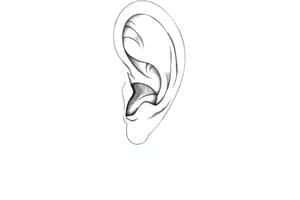Podcast
Questions and Answers
The external auditory canal contains hair, sebaceous glands, and ceruminous glands, which secrete a brown, waxlike substance called ______
The external auditory canal contains hair, sebaceous glands, and ceruminous glands, which secrete a brown, waxlike substance called ______
cerumen
The Eustachian tube connects the middle ear to the ______
The Eustachian tube connects the middle ear to the ______
nasopharynx
The tympanic membrane is also known as the ______
The tympanic membrane is also known as the ______
eardrum
The 3 smallest bones in the body are the Malleus, Incus, and ______
The 3 smallest bones in the body are the Malleus, Incus, and ______
The cochlea is responsible for ______
The cochlea is responsible for ______
The semicircular canals are responsible for ______
The semicircular canals are responsible for ______
Manipulation of the auricle does not normally elicit ______
Manipulation of the auricle does not normally elicit ______
The examiner then whispers softly from a distance of 1 or 2 feet from the unoccluded ear and out of the patient’s sight. The patient with normal acuity can correctly repeat what was ______
The examiner then whispers softly from a distance of 1 or 2 feet from the unoccluded ear and out of the patient’s sight. The patient with normal acuity can correctly repeat what was ______
A tuning fork (ideally, 512 Hertz [Hz]), set in motion by grasping it firmly by its stem and tapping it on the examiner’s knee or hand, is placed on the patient’s head or forehead; use in problem w/ outer and middle ear Hearing is better in affected area (outer and middle ear ______)
A tuning fork (ideally, 512 Hertz [Hz]), set in motion by grasping it firmly by its stem and tapping it on the examiner’s knee or hand, is placed on the patient’s head or forehead; use in problem w/ outer and middle ear Hearing is better in affected area (outer and middle ear ______)
Air conduction is louder than bone conduction (sensorineural hearing ______)
Air conduction is louder than bone conduction (sensorineural hearing ______)
Bone conduction is longer than air conduction (conductive hearing ______)
Bone conduction is longer than air conduction (conductive hearing ______)
Normal: 0-15 db ; 200,000 Hz - >30 db =critical for hearing ______
Normal: 0-15 db ; 200,000 Hz - >30 db =critical for hearing ______
Flashcards are hidden until you start studying




